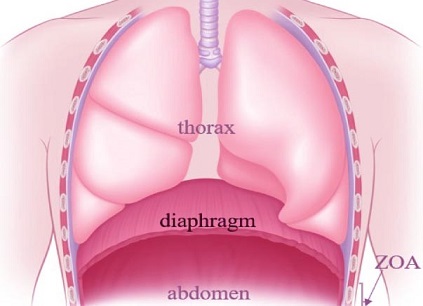Sebastian Lavoie Fact checked by:Thailand Medical News Team Sep 07, 2024 1 year, 3 months, 3 weeks, 2 days, 22 hours, 51 minutes ago
Medical News: The long-term consequences of COVID-19 are continuing to unfold, and a new study offers fresh insights into a key issue faced by many survivors. Researchers from the Medical University of Silesia and Opole University of Technology, Poland, have discovered a significant link between diaphragm muscle atrophy and the ongoing physical difficulties experienced by those who have recovered from the virus. This
Medical News report highlights their findings, explaining how diaphragm atrophy might be at the root of persistent fatigue and breathlessness. For many COVID-19 survivors, such symptoms persist for months after infection, significantly impacting daily life.
 Diaphragm muscle atrophy linked to long-term fatigue in COVID-19 survivors
Diaphragm muscle atrophy linked to long-term fatigue in COVID-19 survivors
The study explored diaphragm muscle function and its potential role in long-term physical impairment in COVID-19 survivors. The findings shed light on why many patients struggle with day-to-day tasks like walking and lifting.
Diaphragm Muscle Atrophy: A Growing Concern
The diaphragm is the main muscle responsible for breathing, and its functionality is crucial for efficient lung ventilation. The new research reveals that diaphragm muscle atrophy - thinning or weakening of the muscle - is a serious problem in COVID-19 survivors. The researchers examined 46 patients who had undergone pulmonary rehabilitation after recovering from the virus. The study found that 69.5% of these individuals exhibited diaphragm muscle atrophy, while 6.5% were suffering from diaphragm paralysis.
The severity of diaphragm atrophy was not associated with factors like age, gender, body mass index (BMI), or the use of oxygen therapy during COVID-19 infection. However, patients who experienced certain symptoms during their infection - like a persistent cough and fever - tended to have better diaphragm function and less muscle atrophy compared to those who did not.
The Link Between Diaphragm Dysfunction and Physical Impairment
The key finding of this study is the strong connection between diaphragm dysfunction and physical impairment. Patients who suffered from diaphragm atrophy showed poorer performance in the six-minute walk test (6-MWT), a common test used to assess aerobic capacity. They also reported more severe levels of fatigue and breathlessness when assessed on the Modified Medical Research Council (mMRC) scale.
According to the study, diaphragm muscle function directly impacts a patient’s ability to engage in physical activities. Many patients who recovered from COVID-19 reported ongoing difficulty with tasks that require physical effort. The research highlights that those with diaphragm atrophy were more likely to feel exhausted and out of breath, even during simple activities like walking or lifting light objects.
Mechanisms Behind Diaphragm Atrophy
The study suggests several mechanisms that may contribute to diaphragm atrophy in COVID-19 patients. One of the primary factors is the inflammatory response triggered by SARS-CoV-2, th
e virus responsible for COVID-19. This response can weaken muscles throughout the body, including the diaphragm.
Additionally, many severely ill COVID-19 patients are placed on mechanical ventilation, which can lead to ventilator-induced diaphragm dysfunction (VIDD). This condition occurs when the diaphragm is inactive for long periods, causing it to weaken or lose mass.
Interestingly, the research also found that patients who retained their sense of smell during their illness were less likely to experience diaphragm muscle atrophy. Though the exact cause of this correlation is unclear, the study suggests that anosmia (loss of smell) may affect the respiratory rhythm, which could impact diaphragm function.
Exercise Tolerance and Diaphragm Function
The six-minute walk test (6-MWT) used in the study revealed the significant impact diaphragm atrophy has on patients' physical capabilities. Patients with diaphragm dysfunction could walk shorter distances during the test, and they also showed lower levels of oxygen saturation after the test, indicating less efficient oxygen exchange.
Moreover, patients with a thinner diaphragm muscle and reduced diaphragm thickening fraction (DTF) experienced higher levels of exertion and breathlessness, as measured by the Borg scale. The DTF index is a crucial indicator of diaphragm strength, and its lower values were found to be strongly associated with decreased exercise tolerance and lower overall physical capacity.
Key Takeaways from the Study
One of the major findings is that diaphragm dysfunction can persist long after a patient has recovered from the acute phase of COVID-19. This muscle atrophy is not necessarily related to the severity of the original infection, meaning even patients with mild or moderate COVID-19 could experience long-term consequences.
The study also highlights that diaphragm muscle thinning does not naturally resolve over time. Without specific rehabilitation, these patients may continue to struggle with physical tasks for extended periods. It was noted that patients who underwent rehabilitation did show improvement, suggesting that early and targeted interventions may be crucial in mitigating these long-term effects.
Conclusion
This research provides valuable insights into the lasting impacts of COVID-19 on muscle function, particularly the diaphragm. The findings underscore the importance of early intervention and rehabilitation for patients recovering from the virus to help restore diaphragm function and improve physical capacity.
For those who continue to experience breathlessness or fatigue months after recovering from COVID-19, this study offers an explanation and a potential path forward through targeted rehabilitation programs.
The study findings were published in the peer-reviewed journal: Life.
https://www.mdpi.com/2075-1729/14/9/1117
For the latest COVID-19 News, keep on logging to Thailand
Medical News.
Read Also:
https://www.thailandmedical.news/news/covid-19-news-study-shows-that-sars-cov-2-infections-can-cause-acute-phrenic-neuropathy-and-diaphragmatic-dysfunction
https://www.thailandmedical.news/news/even-asymptomatic-and-mild-covid-19-causes-neuromuscular-damage-to-the-diaphragm-resulting-in-the-long-covid-manifestations-of-fatigue-and-dyspnea
https://www.thailandmedical.news/news/covid-19-news-post-covid-respiratory-muscle-weakness-and-reduced-exercise-capacity-is-associated-with-reduced-phrenic-nerve-cmap
